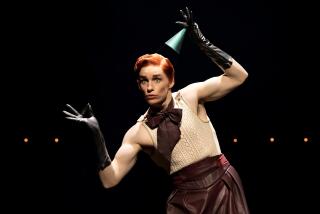‘Anna Karenina’ review: Joe Wright’s artifice overshadows actors
“Anna Karenina,” director Joe Wright’s startling new vision of the Tolstoy classic, is all dressed up with no place to go. Starring Keira Knightley, Jude Law and Aaron Taylor-Johnson in the tale of passion and impropriety in Imperial Russian society, circa 1870, the production is bold, sumptuous, ambitious and yet bound by its own self-imposed conventions.
In a rash move, Wright has confined most of the sweeping story to a single decaying theater. Literally all of Anna Karenina’s world is that stage, its action unfolding in odd nooks and crannies of the ancient structure, much of it on catwalks and along backstage corridors. Prop rooms become drawing rooms, the auditorium subs for a ballroom, an ice rink, a horse track. You might think that playwright Tom Stoppard, who adapted the novel, had a hand in the staging, but this was Wright’s illusion — both a brilliant and a baffling one.
The idea of putting polite society on a stage is a clever starting point. Even as Leo Tolstoy first imagined it, everyone in Moscow and St. Petersburg’s top drawer, where the story takes place, is careful in playing their roles. Until, that is, Anna (Knightley) breaks form and falls passionately and fairly publicly in love with the dashing young Count Vronsky (Taylor-Johnson). Anna’s indiscretion is so out of character that Anna’s husband Karenin (Law), a proper government official, meets the idea of her promiscuity with disbelief that slowly dissolves, like a bitter pill, into distaste. Law is outstanding in his restraint and his receding hairline.
INTERACTIVE: Tricks to turning pages into frames
Stoppard has stripped Tolstoy’s sprawling fiction down to focus solely on matters of the heart, that well-known maze of misplaced affections. It begins with an indiscreet dalliance by Anna’s brother Oblonsky, Matthew Macfadyen exceptional as that lovable cad. It has put his marriage to perpetually pregnant Dolly (Kelly Macdonald) at risk, and Anna’s been enlisted to travel from her St. Petersburg home to Moscow to help him patch things up. At the same time, a young landowner named Levin (Domhnall Gleeson) has traveled to the city to propose to Dolly’s younger sister Kitty (Alicia Vikander), who’s become infatuated with the charming Vronsky. Everything changes when Vronsky first spies Anna disembarking the train — a chance encounter that sparks the flirtation, obsession and destruction that will follow.
When the film opens with a curtain rising on an elegant night at the theater, it seems like a lovely invitation to the party. But at some point it begins to register that something very unusual is afoot. Backdrops provide the clouds and star-filled skies; ballroom dances are choreographed so specifically that even the slightest brush of fingertips against shoulders is completely in concert. The harvest at Levin’s farm is poetic, a haiku of scythes cutting through the wheat, their arcs an alliteration.
It is impossible not to be captivated by the visual artistry that infuses the film. The production design by Sarah Greenwood, set design by Katie Spencer, choreography by Sidi Larbi Cherkaoui and costumes by Jacqueline Durran are so superlative that they emerge as characters in their own right. Layers of subtext exist with the folds of a gown, every prop in hand. That Karenin’s world of papers and bureaucracy is filled with timepieces down to the pocket watch he is so often checking is but one of many considered choices.
Wright has done some of his best work on period pieces that starred Knightley — “Pride & Prejudice” in 2005, “Atonement” two years later. Beautifully shot — as “Anna Karenina” is as well, by cinematographer Seamus McGarvey — they were more traditional in their approach. Perhaps that is why the filmmaker has pursued such a different and daring path with this film. The danger, and “Anna Karenina’s” downfall, is that the rich and inventive visual palette vies for attention with the actors.
That is saying a lot because beginning with Knightley, this cast puts hearts and anguish on the line in trying to bring an emotional reality to the artificial world Wright has dropped them into. Knightley, in particular, uses her passion and her pain to try to punch through the walls that have been constructed around her. The pleasure she finds in Vronsky is just as unbridled. Best is the way Knightley embodies Anna’s insistence that she be free to feel whatever is in her heart. But you always sense the edges, and the limits, that Wright’s theater of the absurd imposes.
The director’s interpretation has a feeling of something to be studied, appreciated, but it makes for a movie that is difficult to enjoy. Rather than being swept up in all the intrigues, you can never forget that this is a “work” of art, or the labor involved in every single scene.
In the end “Anna Karenina” lets you down — visually stunning, emotionally overwrought, beautifully acted, but not quite right.
---
MPAA rating: R for some sexuality and violence
Running time: 2 hours, 10 minutes
Playing: At ArcLight Hollywood
PHOTOS AND MORE
VIDEO: A guide to upcoming movies
The Envelope: Awards Insider
PHOTOS: NC-17 movies: Ratings explained
More to Read
The biggest entertainment stories
Get our big stories about Hollywood, film, television, music, arts, culture and more right in your inbox as soon as they publish.
You may occasionally receive promotional content from the Los Angeles Times.







